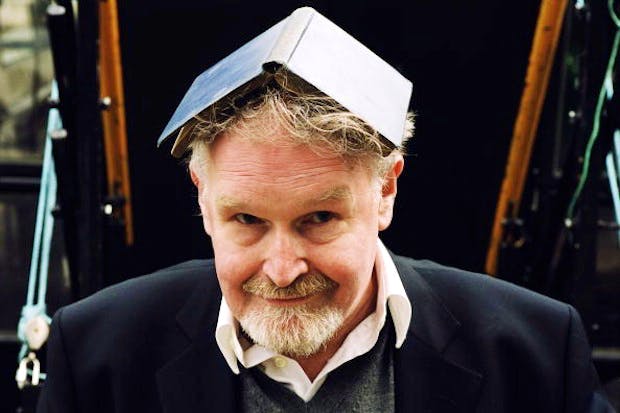The SNP’s Fiona Hyslop is not an obvious candidate to lead a cultural revolution. The Scottish Government’s Cabinet Secretary for Culture, Tourism and External Affairs is more Nicola Murray than Nicola Sturgeon. Hyslop has a permanent look of terror that someone might ask her a question but she’s harmless enough. Stick a few flags and a bowl of borscht in her office and tell her she’s at the UN and she’d be happy enough. Yes, she’s a bit clueless, pretty forgettable and has achieved almost nothing in eight years but it could be worse; she could be Mike Russell.
That’s why I’m not terribly worried about the latest tussle between the notions in her head and the outside world. To be sure, there is a chilling ring to the words. Artists, she decreed, ‘don’t have to be close to government. They just have to have a common understanding of what the country wants. This is a way of bridging, of helping ambition for the country.’
Admittedly, this sounds sinister. A nationalist government minister urging artists to channel the popular will into their work, to make art in service of the nation. Art should challenge society, not be an echo chamber for the establishment dogma of the day. Besides, what the country wants is the Great British Bake-Off and excessively bronzed Basildon sales reps dumped on a Spanish island.
It’s not altogether clear what Hyslop envisions ‘understanding’, ‘ambitious’ art to look like or what purpose it would serve. Should Inspector Rebus spend less time probing the minds of murderers and more time fisking the GERS figures? Should Navid stock more copies of the National to raise the consciousness of Craiglang? Funk Wav Bounces is great, Calvin Harris, but wouldn’t an album on BBC weather maps as a tool of cultural oppression be more useful?
The mystery of Hyslop’s remarks is that she felt the need to make them at all. Far from a surfeit of independence, many of Scotland’s artists have spent the past five years waving their paintbrushes like pom-poms for the SNP. This reached its apotheosis during the 2014 referendum, when the ‘creative community’ put the voters on notice of what was expected of them.
Two months before the vote, Alan Warner, who writes books you haven’t read, urged Scots to think of the intelligentsia when casting their vote:
‘Think on this: if there was a no vote, has there ever been another European country where a ‘progressive’ – and to use two pompous words – ‘intelligentsia’, has united in a liberation movement, yet the majority has finally voted against the aspirations of this movement? A no vote will create a profound and strange schism between the voters of Scotland and its literature; a new convulsion. It will be the death knell for the whole Scottish literature ‘project’ – a crushing denial of an identity that writers have been meticulously accumulating, trying to maintain and refine. With a no vote, a savage division will suddenly exist between the values of most of our writing – past and present – and the majority of our people.’
But the people let the intellectuals down and that was the last we heard from Scottish literature. All we have up here now are a few Danielle Steels and a dog-eared copy of Eat, Pray, Love.
Vast swathes of the cultural and intellectual elite believe it is their duty to have ‘ambition for the country’; that their art, or what they try to pass off as art, should not speak to Scotland but for it. And whether it’s Alan Bissett, ever on the brink of another act of free verse, or Eddi Reader, Scotland’s artists offer a vision of nationalism far removed from the pleasantries and euphemisms of Nicola Sturgeon. It is in art that Scottish nationalism becomes unleashed — and unhinged. Foul-tempered, paranoid, self-pitying, and aggrieved, this is an altogether rawer, more authentic nationalism, one that you can respect more than the SNP’s ‘civic nationalism’ because it is at least honest.
What both nationalisms share — and this is their common weak point — is the superstition that Scotland and England are fundamentally different nations, peoples, and cultures. In their opposition to independence, the entertainment they turn to, and the art they appreciate, Scots defy this artificial border, displaying a more fluid identity. Few things inspire more disdain among Scotland’s curious band of establishment artists, perhaps the only artists anywhere in the world who side with the government against the people. It drives the novelist Alasdair Gray to divide English migrants to Scotland into ‘settlers’ and ‘colonists’ and complain at the hiring of English arts administrators to run Scottish cultural bodies. (‘These colonists were invited here and employed by Scots without confidence in their own land and people.’) It prompts poet Liz Lochhead to lament ‘a shortage of Scottish people working in the National Theatre of Scotland’. Even Hogmanay, we are told, is becoming too English.
The affliction of Scotland’s artist-activists is not distance from the national movement but from the national mood. Chauvinism, not cosmopolitanism, is their weakness. They see a country under the British jackboot which is relaxed about it. This they cannot understand or explain. They have ambition for Scotland but Scotland doesn’t have ambition for itself.







Comments